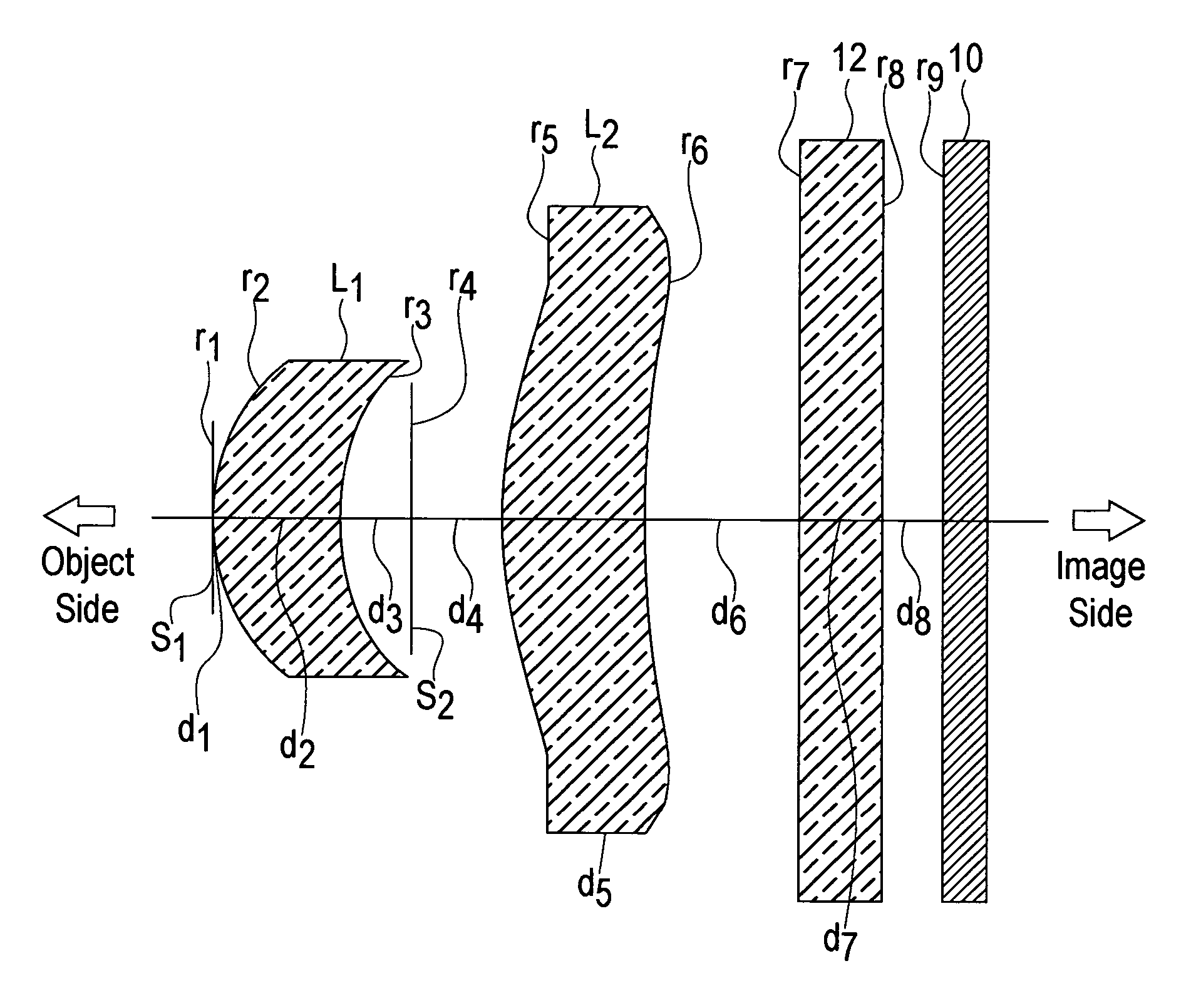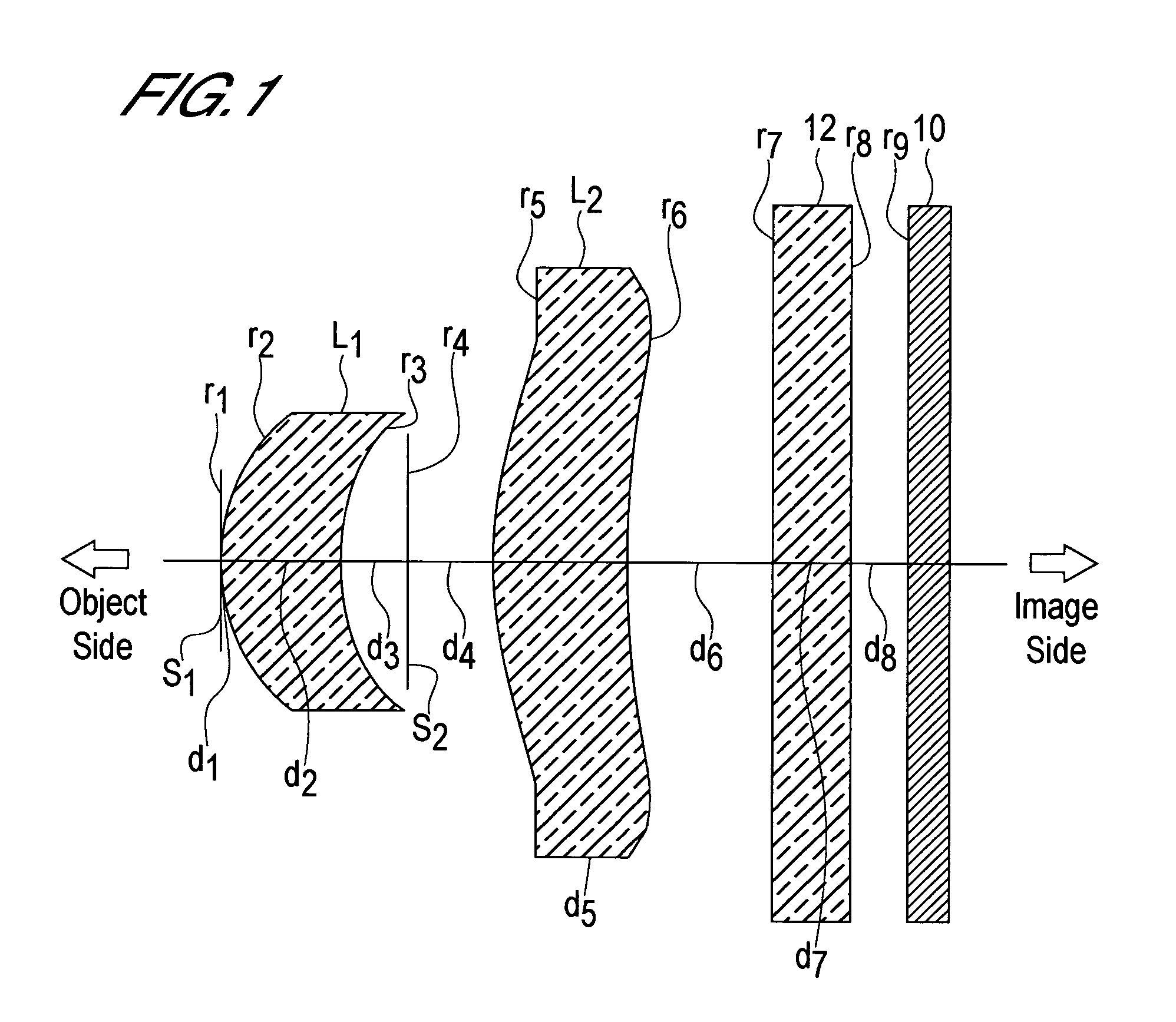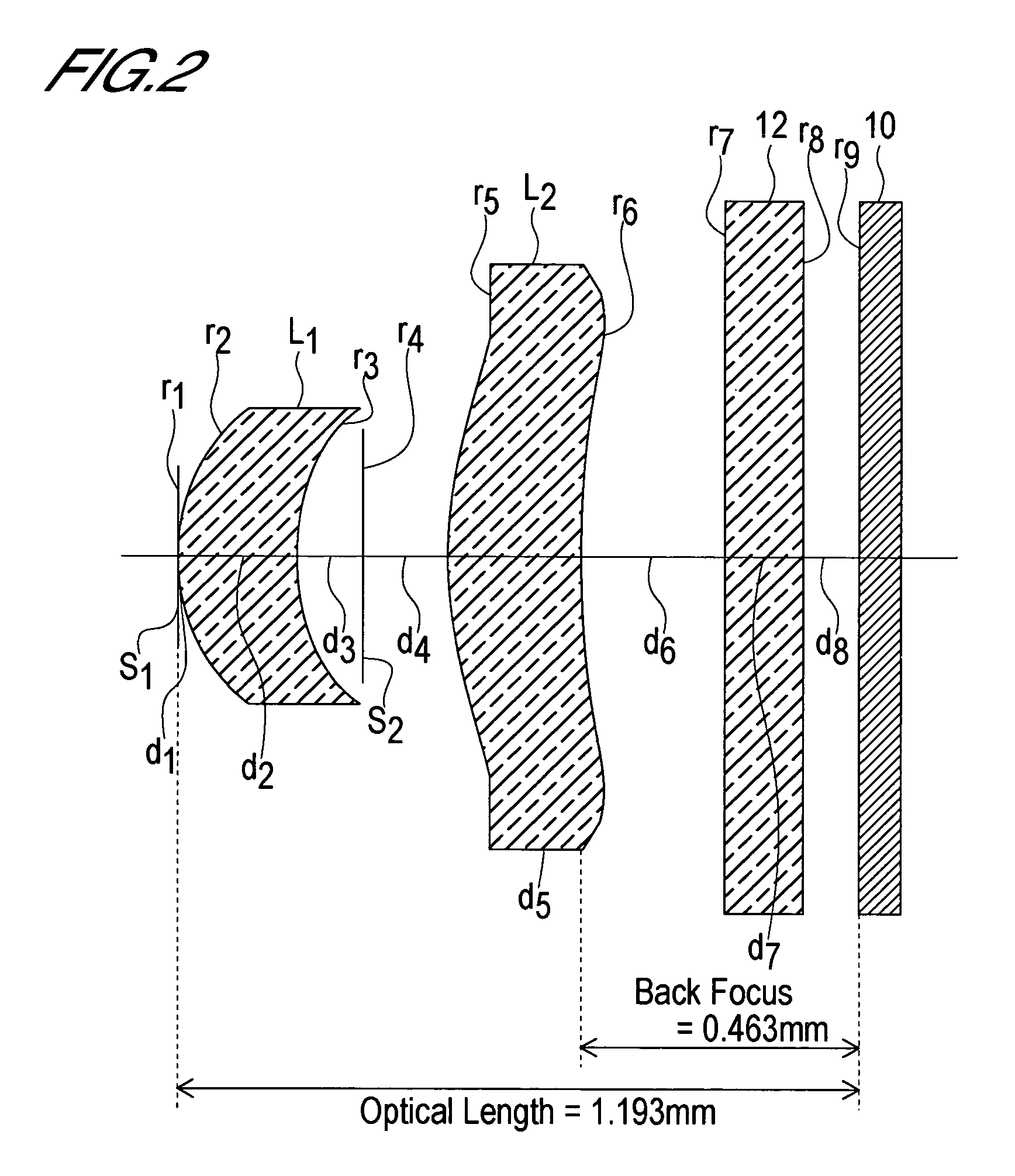Imaging lens
a technology of imaging lens and lens body, which is applied in the field of imaging lens, can solve the problems of insufficient compactness of lens system, inability to design a sufficiently compact lens system, and inability to enlarge the optical length of the lens, so as to achieve satisfactory image, short lens optical length, and satisfactory brightness.
- Summary
- Abstract
- Description
- Claims
- Application Information
AI Technical Summary
Benefits of technology
Problems solved by technology
Method used
Image
Examples
embodiment 1
[0082] (A) The focal length f1 of the first lens L1 is 1.63 mm.
[0083] (B) The focal length f2 of the second lens L2 is 1.74 mm.
[0084] (C) The combined focal length f for all lenses is 1.0 mm.
[0085] (D) The back focus bf is 0.463 mm.
[0086] (E) The optical length d is 1.193 mm.
[0087] (F) The interval D2 between the first lens L1 and the second lens L2 is 0.2738 mm.
[0088] (G) The F-number Fno is 3.0.
[0089] Hence:
f1 / f2=1.63 / 1.74=0.9368
bf / f=0.463 / 1.0=0.463
d / f=1.193 / 1.0=1.193
D2 / f=0.2738 / 1.0=0.2738
Fno=3.0
[0090] Therefore the lens system of Embodiment 1 satisfies all of the following condition equations (1) through (5).
0.3<f1 / f2<1.0 (1)
0.4<bf / f<0.5 (2)
1.0<d / f<1.3 (3)
0.12<D2 / f<0.30 (4)
2.0no<4.0 (5)
[0091] As indicated in Table 1, the aperture diaphragm S1 is provided at the position of the first surface r2 (the object-side surface) of the first lens L1. The second diaphragm S2 is provided at the position 0.1217 mm (d3=0.1217 mm) behind the sec...
embodiment 2
[0098] (A) The focal length f1 of the first lens L1 is 1.36 mm.
[0099] (B) The focal length f2 of the second lens L2 is 2.48 mm.
[0100] (C) The combined focal length f for all lenses is 1.0 mm.
[0101] (D) The back focus bf is 0.454 mm.
[0102] (E) The optical length d is 1.102 mm.
[0103] (F) The interval D2 between the first lens L1 and the second lens L2 is 0.1727 mm.
[0104] (G) The F-number Fno is 3.0.
[0105] Hence:
f1 / f21.36 / 2.48=0.5484
bf / f=0.454 / 1.0=0.454
d / f=1.102 / 1.0=1.102
D2 / f=0.1727 / 1.0=0.1727
Fno=3.0
[0106] Therefore the lens system of Embodiment 2 satisfies all of the following condition equations (1) through (5).
0.3<f1 / f2<1.0 (1)
0.4<bf / f<0.5 (2)
1.0<d / f<1.3 (3)
0.12<D2 / f<0.30 (4)
2.0no<4.0 (5)
[0107] As indicated in Table 2, the aperture diaphragm S1 is provided at the position of the first surface r2 (the object-side surface) of the first lens L1. The second diaphragm S2 is provided at the position 0.1007 mm (d3=0.1007 mm) behind the seco...
embodiment 3
[0114] (A) The focal length f1 of the first lens L1 is 1.29 mm.
[0115] (B) The focal length f2 of the second lens L2 is 2.89 mm.
[0116] (C) The combined focal length f for all lenses is 1.0 mm.
[0117] (D) The back focus bf is 0.462 mm.
[0118] (E) The optical length d is 1.079 mm.
[0119] (F) The interval D2 between the first lens L1 and the second lens L2 is 0.1435 mm.
[0120] (G) The F-number Fno is 3.0.
[0121] Hence:
f1 / f2=1.29 / 2.89 0.4464
bf / f=0.462 / 1.0=0.462
d / f=1.079 / 1.0=1.079
D2 / f=0.1435 / 1.0=0.1435
Fno=3.0
[0122] Therefore the lens system of Embodiment 3 satisfies all of the following condition equations (1) through (5).
0.3<f1 / f2<1.0 (1)
0.4<bf / f<0.5 (2)
1.0<d / f<1.3 (3)
0.12<D2 / f<0.30 (4)
2.0no<4.0 (5)
[0123] As indicated in Table 3, the aperture diaphragm S1 is provided at the position of the first surface r2 (the object-side surface) of the first lens L1. The second diaphragm S2 is provided at the position 0.0861 mm (d3=0.0861 mm) behind the sec...
PUM
 Login to View More
Login to View More Abstract
Description
Claims
Application Information
 Login to View More
Login to View More - R&D
- Intellectual Property
- Life Sciences
- Materials
- Tech Scout
- Unparalleled Data Quality
- Higher Quality Content
- 60% Fewer Hallucinations
Browse by: Latest US Patents, China's latest patents, Technical Efficacy Thesaurus, Application Domain, Technology Topic, Popular Technical Reports.
© 2025 PatSnap. All rights reserved.Legal|Privacy policy|Modern Slavery Act Transparency Statement|Sitemap|About US| Contact US: help@patsnap.com



